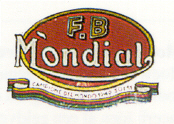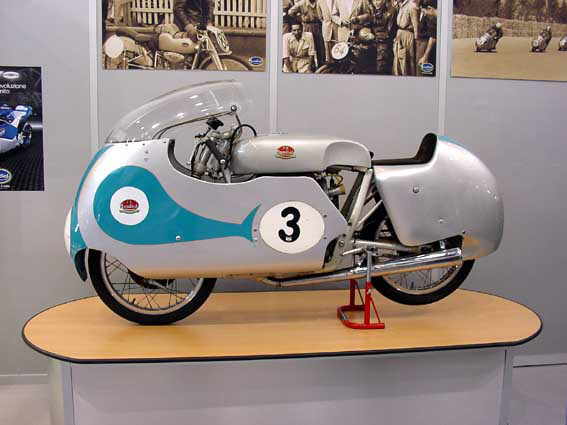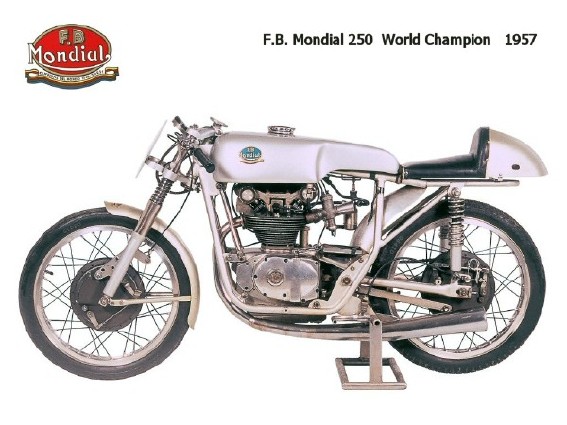|



|
|

Mid-80ies, I
decided to acquire a single cylinder italian vintage
motorcycle, most probably an Aermacchi. It wasn't to be
larger than 250cc and had to be 4-stroke. I was referred to
Heinz Laux, a collector specializing in Aermacchis and
Ducatis. He was anxious to help in any way towards an
Aermacchi, but he showed me his two F.B.Mondial 200SS, one
of which he was willing to part with. He explained that, if
I was really serious about having a piece of italian machine
building at it very best, I should take the
Mondial.
The Mondial was not
in running condition in any way, but it was complete with
the original italian documents showing it to have been
registered in March, 1954. I later located and acquired
another 1954 200SS in very bad condition as a parts bin. To
my knowledge, there are at the most 5 of this model in
Germany. I have seen only 4, two of which are
mine.
Based on the
original DOHC design from Oreste Drusiani for the 125cc GP
racer which won the 1949, 50, and 51 world championships, a
125 SOHC production racer and street versions with a SOHC
175cc and pushrods with 125cc and 200cc were developed using
the same crankcase/transmission assembly and barrel. only
the timing side cover was changed as needed and of course
heads differed, but all had the same hemi layout and hairpin
valve springs. The DOHC
250 GP racer was
also built until Mondial retired from racing after winning
the 1957 250cc world championship with
Provini.
Unlike almost any
other single cylinder engine, the Drusiani design specifies
a tunnel
crankcase, a one-piece design with bearing
plate on the left
side for both crankshaft and transmission shafts. the
primary drive, pinion
and 13 plate clutch,
are outside this sideplate. The housing has another separate
sideplate with oilseal outside of which the flywheel runs in
the typical italian style. The flywheel is fixed on the
crankshaft taper without a key and drives the pinion, which
can revolve freely on the crank, by dog clutch through an
oilseal; the flywheel hub has its own rollerbearing. With
the necessary spacers, the complete assembly aligns the
crank in the crankase. Because of this design, the complete
engine can be assembled and disassembled in the frame.
Likewise, the camshaft can be changed in 10 minutes, and the
entire transmission in about an hour.
On the right side,
the
timing side, the
crankshaft runs in cage-less rollerbearings, allowing the
crank to wander with the heat expansion of the casing. The
gear oilpump is driven by worm gear directly off the crank
and the camshaft by the the requisite 2:1 straight-cut
gears. In the SOHC and DOHC versions there is a layshaft
instead of the cam for the gear tower, kingshaft or timing
chain; all three designs were variously used. Another
layshaft drives the generator
or magneto as the case may be. The kickstarter connects to
this intermediate gear when present. Last versions of the
250cc
GP engine drive
the breaker points directly off this gear; the recess for
the magneto is blocked off. It can be readily seen that all
the gears are straight cut. The gear tower or chain housing
of the OHC engines is set on the side cover which in any
case carries the crank, cam, and layshaft bearings and the
oil main from the pump to both crank and cam. Pushrod
engines have "mushroom" tappets both bottom and top
actuating eccentrically adjustable rockers. The pushrods
themselves are aluminum. Oil feed to the head is through the
barrel casting in the SOHC and pushrod versions and by
separate line in the DOHC, but very often as in
my
engine, a
separate line was added to the simpler engines because the
seals between head and Barrel were very touchy. In the same
picture, the original Dellorto 27SSF with size II separate
floatbowl can also be seen. The 32mm header and long
megaphone
are original.
The frame is the
standard type of closed double tube, brazed with lugs. There
is an additional stiffening tube between the steering head
and the rear frame which is bolted in after the engine has
been mounted. This tube can just be seen under the tank in
the side
view. The very
substantial hydraulic front
fork has 35mm
staunchions that would be comparable to a 50mm fork by
today's standards. The steering head has the usual friction
steering damper. Tires are stipulated at 2,50/19 front and
2.75/19 back, both on 1.6" rims. I have 2.50/19 in front and
3.00/19 in back at the moment. The bike weighs in at 110kg
with 5ltrs. in the tank.
This is the world
championship machine for 1957





|



